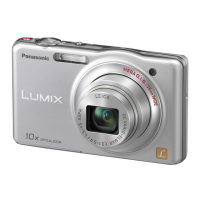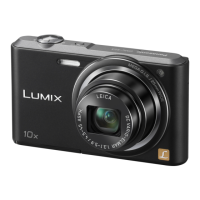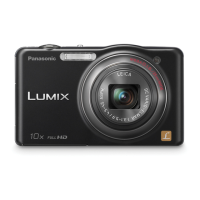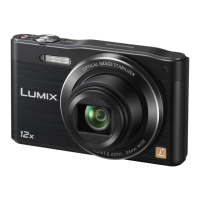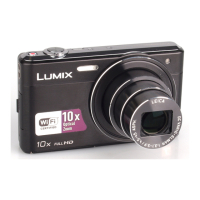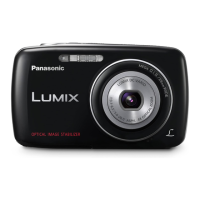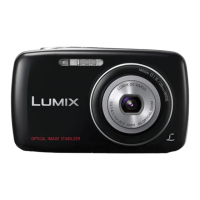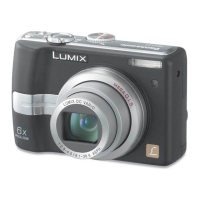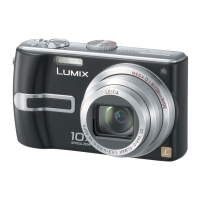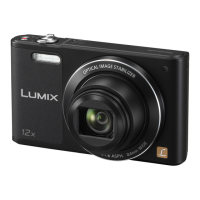
Do you have a question about the Panasonic Lumix DMC-SZ10 and is the answer not in the manual?
| Sensor | CCD |
|---|---|
| Optical Zoom | 12x |
| Digital Zoom | 4x |
| LCD Screen Resolution | 230, 000 dots |
| Video Resolution | 1280 x 720 (HD), 640 x 480 (VGA), 320 x 240 (QVGA) |
| Built-in Flash | Yes |
| Image Stabilization | Optical Image Stabilization |
| Connectivity | AV Output (PAL/NTSC), USB |
| Battery | Lithium-Ion Battery Pack |
| Battery Life | Approx. 250 pictures |
| Weight | 177g (with Battery and SD Card) |
| Effective Pixels | 16.1 Megapixels |
| ISO Sensitivity | 100-1600 (Auto), 1600-6400 (High Sensitivity Mode) |
| LCD Screen Size | 2.7-inch |
Instructions for dealing with lens fogging caused by ambient temperature or humidity changes.
Details the function and operation of the camera's directional and selection buttons.
Describes how the monitor can be rotated for flexible shooting angles and compositions.
Information on compatible batteries and how to use the AC adapter for power supply.
Instructions for charging the camera battery using the AC adapter and a wall outlet.
Instructions for charging the camera battery via USB connection to a computer.
Details on estimated number of shots and recording time for still images.
Details on estimated recording time for motion pictures based on quality settings.
Information on the camera's internal memory capacity and how to use it.
Details on compatible SD, SDHC, and SDXC memory card types and specifications.
Estimated number of pictures based on memory card size and chosen picture size.
Estimated recording time for motion pictures based on quality and card size.
Guidance on holding the camera securely and using the strap correctly to prevent drops.
Advice on techniques and settings to avoid blur caused by camera movement.
How the camera identifies scenes and automatically optimizes settings for them.
How the camera adjusts exposure for subjects against bright backgrounds.
Information on available flash settings and how they affect the image.
Explains focus indication, AF area, and the camera's focus range.
Advice for focusing in challenging conditions like low light or moving subjects.
Guidance on using zoom during video recording and its effect on sound.
How to play recorded video files and use playback controls.
How to view multiple images simultaneously on the screen.
How to zoom in on images during playback for detailed viewing.
Steps to delete one picture at a time from the camera's storage.
How to delete multiple pictures or all images stored on the camera.
Introduction to the camera's menu system and its main categories like Rec, Playback, etc.
How to exit the menu system and return to the shooting or playback screen.
Highlights important settings like Clock Set, Economy, and Auto Review.
Details on setting the camera's clock and managing world time for different locations.
Settings for airplane mode, beep sounds, and shutter sound customization.
Options for adjusting monitor brightness, contrast, and color tint.
Adjusting monitor brightness for different lighting conditions or camera angles.
How to check the angle of view during motion picture recording.
Settings for auto power off, monitor power saving, and auto review duration.
Option to reset exposure compensation settings to default values.
How to reset camera settings, change language, and manage Wi-Fi settings.
Settings for TV output and memory card/built-in memory formatting.
How to activate and use the mode for taking self-portraits easily.
Customization options for self-portraits like soft skin, shot count, and countdown.
How to adjust specific Self Shot parameters like slimming mode through the Rec menu.
Guidance on smoothly panning the camera to capture panorama images correctly.
Different display layouts available during recording: normal, no display, and guidelines.
Display options available during playback: normal, info, and no display.
How to use on-screen guide lines for better photo composition.
Understanding indicators for different zoom types and magnification levels.
How to use the optical zoom for high-quality magnification.
Using EZ zoom for further magnification without quality loss.
Utilizing Intelligent Zoom for enhanced magnification with minimal quality degradation.
Understanding digital zoom capabilities and its impact on image quality.
How to select and adjust flash modes for different shooting situations.
Table showing which flash settings are available in different recording modes.
Details on flash effective range and associated shutter speeds for each setting.
Emphasizes colors for a pop art look.
Creates a faded, vintage image appearance.
Adds a bright, soft, and nostalgic feel to images.
Produces a bright, airy, and soft overall image feel.
Adds a dark, relaxing feel and enhances bright parts.
Creates a sepia-toned image.
Creates a higher contrast black and white picture.
Gives photos a dramatic contrast look.
Optimizes brightness for both dark and bright parts of an image.
Creates a dramatic color look with adjustable color tones.
Reduces peripheral brightness for a toy camera impression, with adjustable color emphasis.
Blurs peripheral areas to create a diorama impression, with adjustable blur direction.
Blurs the overall image for a soft feel.
Transforms light points into a star effect.
Leaves one selected color while making the rest black and white.
Guidance on smoothly panning the camera to capture panorama images correctly.
Details on panorama image resolutions and how to play them back.
Optimizes settings for outdoor portraits, enhancing appearance and skin tones.
Enhances skin texture for softer-looking portraits.
Ideal for capturing wide landscape views.
Optimized for capturing fast-moving sports or events.
Captures people and backgrounds with near real-life brightness in low light.
Captures vivid nightscapes with optimized settings.
Combines multiple exposures for rich gradation in high-contrast scenes.
Captures food with natural hues, unaffected by ambient restaurant light.
Modes for capturing babies, pets, and sunset views, with options for setting birthdays.
Minimizes jitter and aids shooting in dimly lit rooms.
Captures vivid starry skies or dark subjects with adjustable shutter speeds.
Prioritizes distant objects for focus when shooting through glass.
How to set the number of pixels for recorded images, affecting detail and print size.
Adjusting ISO sensitivity for shooting in different lighting conditions.
Adjusting White Balance to ensure accurate color representation under various light sources.
Explains Auto White Balance function and how to set it manually.
Choosing autofocus methods like Face Detection, 9-Area, or 1-Area for optimal focus.
How Face Detection works, its indicators, and common failure scenarios.
Explains i.Exposure for brightness/contrast, i.Zoom, and Digital Zoom.
How to take continuous shots at different speeds and maximum pictures.
How the AF assist lamp aids focusing in low light and its limitations.
How the camera corrects red-eye and reduces blur from camera shake.
Options for imprinting dates on photos and configuring Self Shot mode details.
Setting the resolution (HD, VGA, QVGA) and aspect ratio for video recording.
How to maintain focus on a subject during video recording.
How to start, control, and operate a slideshow of images.
How to search and play back images organized by categories.
Searching and viewing images based on the date they were recorded.
How to start, control, and operate a slideshow of images.
Adjusting screen effects, duration, and repeat options for slideshows.
Details on the categories available for sorting and searching images.
How to apply artistic effects to recorded pictures after shooting.
Applying creative retouch effects to recorded pictures via the Playback menu.
Adding GPS location data from a smartphone to recorded images.
How to pause or delete recorded location data.
Reducing image resolution for web use or email, with single or multi-image options.
Enlarging and clipping parts of a picture to improve composition or focus.
Setting protection for selected images to prevent accidental deletion.
How to remove protection from all protected images.
Copying images between the camera's built-in memory and a memory card.
General advice and precautions for using the camera's Wi-Fi capabilities.
Precautions regarding interference, unauthorized networks, and data security.
Essential steps before using the Wi-Fi function, like setting date/time.
Explains the Wi-Fi connection lamp and the functions of the [Wi-Fi] button.
Overview of remote shooting, playback, and location data transfer using a smartphone.
Overview of sending images to a PC, including supported formats and transfer methods.
Guide to downloading and installing the required smartphone application.
Steps to initiate a new Wi-Fi connection between the camera and a smartphone.
Instructions for connecting an iOS device using a QR code for simplified setup.
Instructions for connecting using SSID and password, for both iOS and Android.
How to properly disconnect the Wi-Fi connection after use.
Steps on the smartphone to start/stop recording and send location data.
Overview of sending images to PC, including supported formats and transfer methods.
Steps required on the camera and PC before transferring images to a computer.
Illustrates the process of automatic image transfer from camera to PC.
Initial setup and ongoing use of the automatic image transfer function.
Steps required before performing automatic image transfers, like turning off the camera.
How to connect the camera to a PC using a wireless access point.
How to connect the camera directly to a smartphone or tablet without an access point.
Using WPS Push-Button or PIN code for easy PC connection.
Searching for and connecting to available wireless access points from a list.
Steps for manually connecting a smartphone/tablet directly to the camera via Wi-Fi.
How to reconnect quickly using previously saved connection records or favorites.
Steps to save Wi-Fi connection settings as favorites for faster access.
Details on which image formats can be sent to smartphones and PCs.
Setting up the automatic image transfer function.
Configuring workgroup settings for PC connections.
Changing the name displayed for the camera on other devices.
Setting a password to protect the Wi-Fi function and personal information.
Displaying the camera's MAC and IP addresses for network identification.
Information on compatible operating systems for PC connection.
Recommended software for viewing and editing images on a computer.
Understanding how images are organized in folders on the camera's storage.
Information on connecting via Picture Transfer Protocol (PTP) mode.
How to select and print one image at a time.
How to select and print multiple images, or all images, at once.
Options for setting print date, number of prints, paper size, and page layout.
List of available paper sizes that can be selected for printing.
Options for arranging multiple pictures on a single sheet of paper.
Explanation of icons and information shown on the monitor while recording.
Explanation of icons and information shown on the monitor during playback.
Explanations for messages related to protected pictures and deletion errors.
Explanations for messages regarding full memory, card errors, and format prompts.
Explanations for system errors, lens operation issues, and card usage errors.
Explanations for memory card errors, folder creation failures, and battery usage errors.
Explanations for Wi-Fi connection failures, network disconnections, and IP address issues.
Solutions for the camera not turning on, turning off unexpectedly, or freezing.
Troubleshooting steps for charging lamp errors and inability to charge the battery.
Solutions for the battery/card door not closing and card recognition problems.
Solutions for pictures not recording, being whitish, over/underexposed, or blurry.
Advice for when the subject is not focused properly or when multiple pictures are taken.
Addressing issues with rough picture quality or noise appearing in images.
Explains variations in brightness/hue and reddish stripes on the monitor.
Solutions for motion picture recording stopping and slow burst shooting speeds.
Guidance on ending Panorama Shot recording correctly and avoiding issues.
Addresses monitor dimming, flickering, brightness issues, and pixel spots.
Solutions for flash not activating, activating multiple times, or being unavailable.
Resolving issues where pictures don't play back, folders are blank, or calendar dates are incorrect.
Addresses issues with red color changing to black and thumbnail display errors.
Explains why motion picture sound might break up during recording.
Steps to resolve issues with Wi-Fi connection establishment, radio waves, and access point display.
Addresses slow connection times when connecting to a smartphone.
Resolving problems with smartphone display, PC recognition, and user account errors.
Addresses settings reset after repair and forgotten Wi-Fi passwords.
Solutions for midway transmission failures and issues with image size or battery status.
Resolving issues with TV display, PC communication, and card recognition by PC.
Addresses issues when the camera cannot be printed from due to printer incompatibility.
Resolving printing cut-offs, panorama print errors, and incorrect language selection.
Addressing AF lamp, camera warmth, lens clicks, and clock reset problems.
Explains image warping, color fringing, and zoom stopping issues.
Addresses non-consecutive file numbers and card formatting limitations.
Keeping the camera away from devices that emit electromagnetic waves.
Avoiding use near radio transmitters and high-voltage lines to prevent interference.
Precautions regarding supplied accessories, chemicals, and material contact.
Guidelines for safely cleaning the camera body, monitor, and lens.
Handling the monitor and lens carefully to prevent damage or malfunction.
Proper handling, storage, disposal, and charging of the camera battery.
Precautions for using the AC adapter, including placement and power connection.
Precautions for memory card handling, disposal, and protecting personal information.
Advice on requesting repairs, transferring devices, and managing data.
Considerations for uploading images to web services, including personal information.
Guidelines for storing the camera and battery for extended periods.
Precautions regarding potential damage or loss of recorded picture data.
Advice on securely attaching and using tripods or unipods with the camera.
